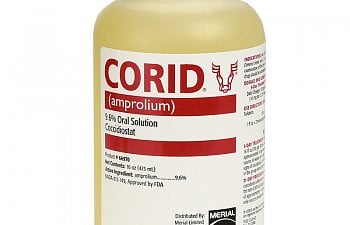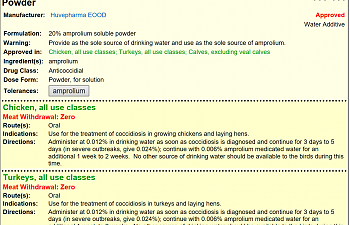Is is possible to treat by giving to chickens individually by syringe?Treating Coccidiosis with Corid, Amprol, AmproMed - The Correct Amprolium Dose


When treating coccidisosis in my own birds I use the severe outbreak dose (0.024%) for 5 days, then the 0.006% amount for 7-14 days.
Liquid dose:
2 teaspoons per gallon for five days, then 1/2 teaspoon for 7-14 days.
Powder dose:
1.5 teaspoons per gallon for five days, then 1/3 teaspoon for 7-14 days.
Math and references below:
The FDA, FARAD, and the mfg's say this:

Source: http://www.farad.org/vetgram/ProductInfo.asp?byNada=033-165
Give amprolium at the 0.012% level as soon as coccidiosis is diagnosed and continue for three to five days. (In severe outbreaks, give amprolium at the 0.024% level.) Continue with 0.006% amprolium medicated water for an additional 1 to 2 weeks. No other source of drinking water should be available to the birds during this time. Make fresh daily.
So what does that mean?
20% Powder
0.024% = no less than 1.5 teaspoons per gallon
0.012% = no less than 3/4 teaspoons per gallon
0.006% = no less than 1/3 teaspoon per gallon

9.6% Liquid
0.024% = no less than 2 teaspoons per gallon
0.012% = no less than 1 teaspoons per gallon
0.006% = no less than 1/2 teaspoon per gallon

Due to some confusion on dose amounts regarding the powder, I decided to do some research and this is what I have so far. For those of you that use powder Corid, if you have been using 1/2 teaspoon per gallon (~270mg) you haven't been using enough.
The preventative dose (.006%) for Corid Powder is 1/3 teaspoon.
The preventative dose (.006%) for Corid liquid is 1/2 teaspoon.
The moderate outbreak dose (.012%) for Corid Powder is 3/4 teaspoon.
The moderate outbreak dose (.012%) for Corid liquid is 1 teaspoon.
The severe outbreak dose (.024%) for Corid Powder is 1.5 teaspoons
The severe outbreak dose (.024%) for Corid liquid is 2 teaspoon.
Corid mixing instructions for preventative (.006%) and moderate (.012%) outbreak dosing.
http://www.corid.com/SiteCollectionDocuments/CORID Slim Jim-All.pdf
Amprol 20% powder:
http://www.asp-inc.com/products/documents/prodinfo/a/amp128.pdf
Amprol 9.6% liquid:
http://www.asp-inc.com/products/documents/prodinfo/a/amp96.pdf
FDA recommendations:
http://www.accessdata.fda.gov/scripts/animaldrugsatfda/details.cfm?dn=013-149
"Chickens
Indications: For the treatment of coccidiosis.
Amount: Administer at the 0.012 percent level in drinking water as soon as coccidiosis is diagnosed and continue for 3 to 5 days (in severe outbreaks, give amprolium at the 0.024 percent level); continue with 0.006 percent amprolium-medicated water for an additional 1 to 2 weeks."
And this link has these instructions:
http://www.drugs.com/vet/amprol-9-6-solution-can.html
"Poultry - as Soon As Caecal Coccidiosis Is Diagnosed, Give 0.024% Amprolium In The Drinking Water For 5 To 7 Days. Continue The Treatment With 0.006% Amprolium Medicated Water For An Additional One To Two Weeks. No Other Source Of Drinking Water Should Be Available To The Birds During This Time."
Here's the math, let me know if I made an error.
- There are 200mg of amprolium in every 1 gram of powder.
- 1 ounce = 3.5 tablespoons = 28.35 grams
- 200mg x 28.35 = 5670mg in 3.5 tablespoons of powder.
- There are 10.5 teaspoons in 3.5 tablespoons
- There are 21 1/2 teaspoons in 10.5 teaspoons
- 5670mg divided by 21 1/2 teaspoons = ~270mg per 1/2 teaspoon
- There are two 1/4 teaspoons per 1/2 teaspoon
- 270 mg divided by 2 = 135mg per 1/4 teaspoon
Amount of Amprolium (Corid or Amprol) powder per 1/4 teaspoon
- One 1/4 teaspoon = 135 mg
- 1/2 teaspoon = 270 mg
- 3/4 teaspoon =405 mg
- 1 teaspoon = 540 mg
- 1 & 1/4 teaspoons = 675 mg
- 1 & 1/2 teaspoons = 810 mg
- 1 & 3/4 teaspoons = 945 mg
- 2 teaspoons= 1080 mg
Amount of Amprolium (Corid or Amprol) liquid per 1/4 teaspoon
There are 4.92892ml/teaspoon, but the numbers above were calculated using 5ml/teaspoon
- One 1/4 teaspoon = 120 mg
- 1/2 teaspoon = 240 mg
- 3/4 teaspoons = 360 mg
- 1 teaspoon = 480 mg
- 1 & 1/4 teaspoons = 600 mg
- 1 & 1/2 teaspoons = 720 mg
- 1 & 3/4 teaspoons = 840
- 2 teaspoons = 960 mg
Here is what's in 1-10ml of the liquid
- 1ml = 96mg
- 2ml = 192mg
- 3ml = 288mg
- 4ml = 384mg
- 5ml = 480mg
- 6ml = 576mg
- 7ml = 672mg
- 8ml = 768mg
- 9ml = 864mg
- 10ml = 960mg
Bottom line, 1 teaspoon (540mg) of powder is equal to 5.625ml of liquid and 1/2 teaspoon powder (270mg) is equal to 2.8125ml liquid.
1/2 teaspoon of 20% powder = 2.8125ml of 9.6% liquid - Both have 270mg of amprolium.
3/4 teaspoon of 20% powder = 4.21875ml of 9.6% liquid - Both have 405mg of amprolium.
1 teaspoon of 20% powder = 5.625ml of 9.6% liquid - Both have 540mg of amprolium.
1.5 teaspoons of 20% powder =8.4375ml of 9.6% liquid - Both have 810mg of amprolium.
1.75 teaspoons of 20% powder = 9.84375ml of 9.6% liquid - Both have 945mg of amprolium.
2 teaspoons of 20% powder = 11.25ml of 9.6% liquid - Both have 1080mg of amprolium.
And if that doesn't convince people, here is another way I did it:
From:
http://www.asp-inc.com/products/documents/prodinfo/a/amp128.pdf:
Dosage Level Mixing Directions
0.024% Dissolve 8 ounces of AMPROL 128 20% Soluble Powder in about five gallons of water in a 50-gallon medication barrel. Stir, then add water to the 50 gallon mark. Stir thoroughly.
0.012% Follow same directions as above but use 4 ounces of AMPROL 128 20% Soluble Powder.
0.006% Follow same directions as above but use 2 ounces of AMPROL 128 20% Soluble Powder.
Facts
- One pack = 10 oz. (283.5 grams)
- One ounce = 28.35 grams
- One ounce of powder = ~3.5 tablespoons
- 200mg amprolium per 1 gram
My twisted math for the .024% level
If 8 ounces (28.35g x 8 = 226.8 grams) are needed for 50 gallons, then 1/50 of that is needed for 1 gallon, right? So that would be 226.8 grams divided by 50 = 4.536 grams per gallon. (doing this as I type, so correct me if I'm wrong, please!)
So how much does a teaspoon of Corid or Amprol powder weigh? Anyone know? Well, time to break out my gram scale and do some weighing... also have a call into the mfg of Corid and I'm expecting a call back from them.
Just got a call back from them and it is 4.536 grams per gallon. He also said that it's a very safe product and the risk of overdosing is very slim.
-Kathy
Disclaimer:
In the past I have treated my chicken chicks with 2 teaspoons of the liquid for 5-7 days, that's it, but I *might* try the .006% follow up the next time I have to treat chicks.
Navigation
Install the app
How to install the app on iOS
Follow along with the video below to see how to install our site as a web app on your home screen.
Note: This feature may not be available in some browsers.
More options
You are using an out of date browser. It may not display this or other websites correctly.
You should upgrade or use an alternative browser.
You should upgrade or use an alternative browser.
Updated - Corid and Amprol (amprolium) Dosing
- Thread starter casportpony
- Start date
- Thread starter
- #722
Yes, instructions here:Is is possible to treat by giving to chickens individually by syringe?
Corid Amprolium Oral Drench Instructions
saracarver3
Songster
- Feb 20, 2021
- 100
- 210
- 151
Is this the same dosing for chicks?
- Thread starter
- #724
It is.Is this the same dosing for chicks?

Treating Coccidiosis with Corid, Amprol, AmproMed - The Correct Amprolium Dose
Treating Coccidiosis with Corid, Amprol, AmproMed
The Correct Amprolium Dose
Treatment
20% Powder
9.6% Liquid
For 3-5 days
1.5 teaspoons per gallon
2 teaspoons per gallon
then for 7-14 days
1/3 teaspoon per gallon
1/2 teaspoon per gallon
When treating coccidisosis in my own birds I...
- casportpony
- 4.95 star(s) 19 ratings
- Comments: 10
- Reviews: 12
- Category: Injuries, Diseases, & Cures

Corid Amprolium Oral Drench Instructions
When treating a bird for coccidiosis one can give an oral drench in addition to their medicated water. Here are the instructions:
9.6% liquid - Do not dilute
Give 0.1 ml per pound of body weight orally once or twice a day for 1-3 days.
or
0.02 ml per 100 grams of body weight orally once or...
- casportpony
- 5.00 star(s) 12 ratings
- Comments: 7
- Reviews: 10
- Category: Injuries, Diseases, & Cures
Help please I'm desperate  I have 14 day Old wyandotte chicks. I noticed 2 were very small, I saw yellow foamy-ish droppings and one girl eats slightly on her side and is a tad less active.
I have 14 day Old wyandotte chicks. I noticed 2 were very small, I saw yellow foamy-ish droppings and one girl eats slightly on her side and is a tad less active.
I suspect coccidia so begin corid 20% at 1.5 teaspoons per gallon. I began treatment 36 hours ago.
All chicks are eating and drinking. I have also been weighing my chicks for the last 7 days, all of which are gaining weight. Even the smaller girls thank God.
My questions are:
1. How long before symptoms improve?
2. Is there anything else I can do?
3. Am I missing something? Could it be a different disease?
I suspect coccidia so begin corid 20% at 1.5 teaspoons per gallon. I began treatment 36 hours ago.
All chicks are eating and drinking. I have also been weighing my chicks for the last 7 days, all of which are gaining weight. Even the smaller girls thank God.
My questions are:
1. How long before symptoms improve?
2. Is there anything else I can do?
3. Am I missing something? Could it be a different disease?
Cocci usually does not bother chicken chicks like they do peachicks. It is more likely a bacterial infection, I would give one drop of Baytril orally and repeat if no progress is made within a day.
Thank you. Is there any harm to giving corid and baytril at the same time?Cocci usually does not bother chicken chicks like they do peachicks. It is more likely a bacterial infection, I would give one drop of Baytril orally and repeat if no progress is made within a day.
- Thread starter
- #728
I have done it. How much do your chicks weigh?Thank you. Is there any harm to giving corid and baytril at the same time?
3 ouncesI have done it. How much do your chicks weigh?
Why would you give a two-week-old chicken chick Corid?I have done it. How much do your chicks weigh?
New posts New threads Active threads
-
Latest posts
-
-
-
Open Contest BYC Poultry Caption Contest 11-21-25 Pic by ella2025
- Latest: BigBlueHen53
-
-
Latest threads
-
-
Rescued chicken in nyc
- Started by Susan Fleming
- Replies: 3
-
Open Contest BYC Poultry Caption Contest 11-21-25 Pic by ella2025
- Started by TwoCrows
- Replies: 8
-
Open Contest BYC Pets & Livestock Caption Contest 11-21-25 Pic by Birdlove2011
- Started by TwoCrows
- Replies: 7
-
Thanksgiving and/or Christmas Memories
- Started by N3mesis_IceWing_NightWing
- Replies: 4
-
-
Threads with more replies in the last 15 days
-
-
-
Ended BYC Poultry Caption Contest 11-07-25 Pic by kattabelly
- Started by TwoCrows
- Replies: 53
-
-
UPDATED serious flystrike
- Started by anomala
- Replies: 52
-
×






